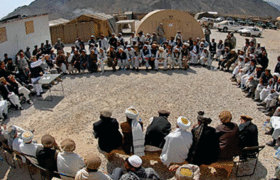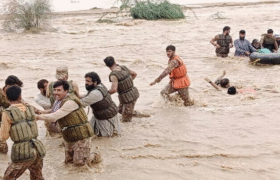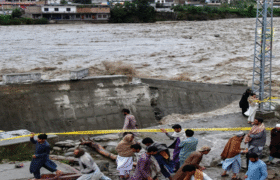Shahzad Masood Roomi
Khyber Pakhtunkhwa (KP) is facing a two-pronged, climate-induced flood challenge during the ongoing monsoon season. Torrential rains across various parts of the province have triggered flash floods, causing widespread damage to infrastructure, homes, and livelihoods. This situation has been compounded by an earlier, unprecedented heatwave that accelerated the melting of over 7,000 glaciers located in KP and Gilgit Baltistan (GB). Temperatures soared to a record 48.5°C in high-altitude areas like Bunji, situated over 10,000 feet above sea level. Consequently, KP now faces heightened climate-related risks, particularly the threat of Glacial Lake Outburst Floods (GLOFs), which pose a serious danger to downstream populations.
Heavy monsoon rains in KP have claimed dozens of lives. According to media reports dated 22nd July, at least 56 people have died, and 69 others have been injured since the onset of the monsoon season on 26 June. Within a 24-hour period between 20 and 21 July, at least 10 fatalities were reported across Khyber Pakhtunkhwa, including six children. In addition to the loss of life, more than 220 homes have been either partially or completely destroyed due to landslides, flash floods, and urban flooding.
The Meteorological Department has issued warnings of flash flooding in seasonal streams and nullahs across several parts of Khyber Pakhtunkhwa, with particular concern for districts including Chitral, Dir, Swat, Buner, Shangla, Kohistan, Battagram, Torghar, and Mansehra. Additional flood alerts have been issued for Abbottabad, Mardan, Swabi, Kurram, and Khyber. Authorities have also warned of an increased risk of landslides in upper districts, which could severely disrupt road connectivity and hinder relief efforts. Many residents have suffered significant economic losses, including the loss of livestock—the sole source of livelihood for many. According to reports, at least 200 cattle have perished in the floods, further compounding the hardships faced by already vulnerable communities. Lower Dir district remains the worst affected due to heavy rainfall, and with fresh warnings of more spells, residents are anxious about rehabilitation efforts once the rainy season ends.
According to estimates by the Meteorological Department, rainfall during the current monsoon season has surged 124% above the normal average. Experts say the scale of devastation underscores both the accelerating impacts of climate change and the state’s ongoing struggle to build climate resilience. Despite repeated warnings and Pakistan’s consistent ranking among the countries most vulnerable to climate change, the magnitude of the damage remains staggering.
Pakistan Army helicopters were called in to Shangla and Buner districts to rescue stranded residents from islands of debris, as roads remain submerged or have been completely washed away in multiple areas. The province, still reeling from the $1.5 billion losses caused by the historic 2022 floods, now faces new climate-induced socio-economic challenges.
Beneath this unfolding human tragedy lies a deeper story of institutional failure at multiple levels. The collapse of homes, for example, is not merely the result of natural forces but stems from a deadly combination of absent urban planning, lack of building quality control, and unchecked illegal constructions along riverbeds.
The crisis has been further exacerbated by the failure to develop adequate water storage systems as a flood control mechanism. Pakistan’s current water storage capacity is alarmingly low—just 30 days’ worth—compared to 900 days in the United States. This storage shortage often forces authorities to release floodwaters into populated areas instead of containing it for drought or peak summer months when water demand rises. This year’s downpour, 82% heavier than that of 2024, didn’t just test infrastructure—it exposed a decaying legacy of neglect left unaddressed since the 2022 super floods.
Among other administrative shortcomings, the early warning system revealed critical gaps, leaving many communities unaware of the impending disaster. The World Food Program’s $9.8 million project in Buner and Shangla, which installed river monitors, facilitated timely evacuations and saved lives. Yet, these localized successes were undercut in more remote areas. Radar blind spots left isolated communities in KP without forecasts. The disconnect between meteorological data and ground-level action remains a deadly gap.
There is unequivocal evidence that climate change is the primary driver of this environmental crisis. In June, temperatures in Gilgit-Baltistan reached an unprecedented 48.5°C—an alarming figure for a mountainous region situated around 1,200 meters above sea level. This temperature anomaly is not only accelerating glacial melt but also triggering imminent threats of GLOFs from 33 high-risk lakes.
Despite contributing only 0.5% to global greenhouse gas emissions, Pakistan remains disproportionately affected by the consequences of climate change. The probability of climate-related fatalities in Pakistan is estimated to be 15 times higher than the global average, underscoring a profound climate injustice.
Addressing this existential threat requires a radical transformation of Pakistan’s climate adaptation strategy—an area where the state continues to exhibit institutional inadequacy. Nature-based solutions such as reforestation of watersheds and restoration of mangrove ecosystems in the Indus Delta must complement infrastructure projects like the Diamer-Bhasha Dam. Studies indicate that every dollar invested in pre-disaster preparedness can yield up to tenfold savings in post-disaster recovery and reconstruction.
Comprehensive legal reforms and strict enforcement are essential to prohibit hazardous practices like riverbed construction. Parallel to this, relocation initiatives—such as Sindh’s successful resettlement of 150,000 flood-affected households—should be expanded to other vulnerable regions, including Swat, Dir, and Chitral. Additionally, the integration of artificial intelligence into early warning systems is imperative. Real-time analysis of variables such as glacial melt, soil saturation, and precipitation can significantly enhance forecasting and support the training of local “flood watchers” in high-risk districts.
As the floodwaters eventually recede, a sobering reality emerges: these catastrophes can no longer be labeled as purely “natural” disasters. Instead, they reflect a dangerous confluence of anthropogenic climate disruption and chronic governance failures, resulting in reactive rather than proactive responses. Critically, Pakistan’s climate diplomacy must evolve to assert that global emitters bear a moral responsibility—not just to provide aid but to offer reparations for the socio-environmental damage caused. Without such recognition, monsoon seasons will continue to claim lives as the cycle of loss and neglect persists.





